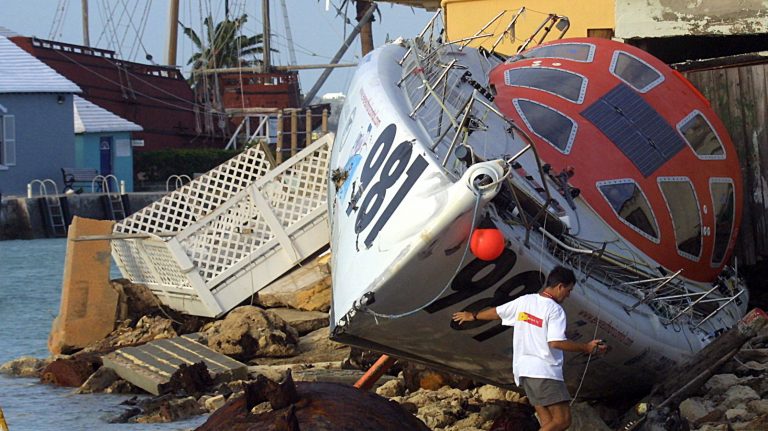By TIM SMITH
THE ORIGINAL BERMUDA HURRICANE
The hurricane that started it all off in Bermuda. The Sea Venture, a small vessel carrying about 150 people, including Sir George Somers, from Plymouth in England to provide relief for settlers in Jamestown, Virginia, is battered by a storm in the Atlantic for four days. The ship is falling apart at the seams, but suddenly finds itself in calm waters off the east of Bermuda. It then becomes wedged in a reef several hundred yards from St Catherine’s Beach before its emigrants clamber on to the pink sands on July 28 to form the first settlement on the island. The story forms the basis of one of William Shakespeare’s final plays, The Tempest.
THE HAVANA-BERMUDA HURRICANE
HMS Valerian, a ship returning after a relief mission in the Bahamas in 1926, is hit by a tremendous storm a few miles before it reaches home.
A handful of sailors and officers cling to the wreckage for several hours before being rescued the next day, but 88 people are killed, making it the deadliest storm ever recorded on the island.
A Court of Inquiry later hears winds were as gentle as 7mph before suddenly ratcheting up into a violent storm, with mountainous seas ripping the vessel apart.
HURRICANE FABIAN
The most notorious storm to hit Bermuda in the modern day, Hurricane Fabian claims four lives and causes $300 million worth of damage in 2003.
Police officers Stephen Symons and Nicole O’Connor, duty police station officer Gladys Saunders and stone mason Manuel Pacheco are all trapped on the Causeway when it is hit by devastating winds and waves.
The body of Mr Symons is discovered at Ferry Reach two days later, but none of the other three are ever found.
Hurricane force winds hit Bermuda for ten hours, causing damage all over the island, including to the House of Assembly and City Hall.
HURRICANE EMILY
Hundreds of roofs blow off homes and public buildings by Hurricane Emily in 1987, and extensive damage is caused to hotels, cars, boats, telephone poles and trees.
Residents are unprepared for the storm after being told by meteorologists the night before that it would merely brush the island with winds of about 40mph.
Yet Emily intensifies at about 4am and hurtles at great pace towards Bermuda, before striking at 7.30am with winds of up to 116mph.
It also boasts a ferocious waterspout that demolishes everything in its path in Warwick, including the roof of a building at the Mermaid Beach Club.
THE POLLOCKSHIELDS HURRICANE
One of the most dramatic rescues in Bermuda’s history takes place while the island is battered by the great hurricane of 1915.
The SS Pollockshields, a First World War supply ship, is lashed by winds of more than 111mph when it crashes into rocks near Elbow Beach.
Residents in Paget, who witness sailors clinging for the lives to the wreckage, embark on a late-night trek to Jew’s Bay, Southampton, from where they collect a whaling boat to use for the rescue.
Whaler Antonio Marshall leads a team of volunteers on four trips to the wreckage, and all but one of the seamen are saved.
The sole fatality is Captain Ernest Boothe, who is killed by a wave while trying to fetch a lifebelt for a crew member.
THE CAUSEWAY HURRICANE
The 19th century saves its worst storm for its final year.
Three-quarters of a mile of the Causeway is destroyed by fierce winds, while numerous homes lose their roofs and Dockyard and Prospect Camp are demolished.
St George’s not only loses much of its property and shoreline – it also sees its connection to the rest of the island disappear for several months.
It means a temporary return for the old horse and ferry system, which had served East Enders before the Causeway opened in 1871.
REID’S HURRICANE
Many families are forced to ride out the storm of 1839 in the open air after losing their roofs.
One cottage in St George’s is even picked up by the wind and blown across a road and into a nearby field.
From one perspective, however, the hurricane proves to be useful timing.
Bermuda’s new governor, Sir William Reid, a keen scientist who is developing theories about hurricanes, has only arrived on the island a few months previously.
Before the storm arrives, he advises residents how to minimise damage. He later uses his experience of the storm to form his next book Progress of the Development of the Law of Storms.
THE GREAT HURRICANE
Fifty ships are driven on land, houses are blown down and great damage is caused to ships and trees as Bermuda suffers one of its worst ever storms in 1780.
It leaves islanders with so many tales of terror that for years it is referred to simply as The Great Hurricane.
One ship drags its anchors near Castle Island, prompting two officers, Richard Aldgate and David Foggo, to climb aloft to try to cut the rigging from the jagged rocks. The pair crash overboard, entwined in the topsail, before the boat itself is destroyed on the rocks.
Remarkably, Mr Aldgate and Mr Foggo are later dragged to safety by soldiers from the King’s Castle, still wrapped in canvas.
FAY AND GONZALO
One major storm a year is bad enough – but in 2014 Bermuda is hit by two in a week.
Fay surges with power and records gusts of up to 120mph as it approaches the island overnight on October 12.
Residents wake to find numerous roads blocked by fallen trees and flooding, while 28,000 Belco customers are without power.
Five days later, Gonzalo pummels the island with sustained winds of 127mph for eight hours, damaging churches, the House of Assembly, gas stations, bars, the Causeway and King Edward VII Memorial Hospital.
There’s one silver lining to the double hurricane – experts say Fay has reduced the sea surface temperatures near the island, thereby weakening Gonzalo and meaning Bermuda is relatively spared.

